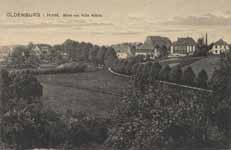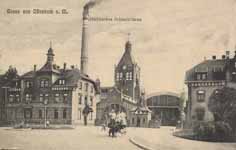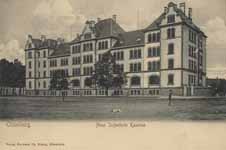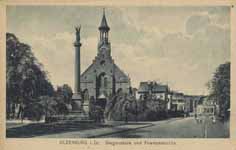.




4, 5, 6,
Oldenburg
Oldenburg (German pronunciation: [ˈɔldənbʊrɡ]) (Low German: Ollnborg) is an independent city in the state of Lower Saxony, Germany. During the French occupation (1810–1814) of the former Duchy of Oldenburg, it was also known as Le Vieux-Bourg in French. The city is situated at the Rivers Hunte and Haaren, in the northwestern region between the cities of Bremen in the east and Groningen (Netherlands) in the west. It has a population of 162,173 (as of 2010), which makes it the fourth biggest city in Lower Saxony after Hanover, Braunschweig and Osnabrück. In German, the formal name is Oldenburg (Oldenburg) or Oldenburg (Oldb) (spoken: Oldenburg in Oldenburg) to distinguish it from the city of Oldenburg in Holstein.
History
The town was first mentioned in 1108, at that time known under the name of Aldenburg. It became important due to its location at a ford of the navigable Hunte River. Oldenburg became the capital of the County of Oldenburg (later of the Duchy, Grand Duchy, and Free State), a small state in the shadow of the much more powerful Hanseatic city of Bremen.[2]
In the 17th century, Oldenburg was a wealthy town in a time of war and turmoil and its population and power grew considerably. In 1667, the town was struck by a disastrous plague epidemic and, shortly after, a fire destroyed Oldenburg. The Danish kings, who were also counts of Oldenburg at the time, were not much interested in the condition of the town and it lost most of its former importance. In 1773, Danish rule ended. It was only then that the destroyed buildings in the city were rebuilt in a neoclassicist style.[2] (In German, the ‘neoclassicist style’ of that period would usually be called klassizistisch, while neoklassizistisch specifically refers to the classicist style of the early 20th century.)
After German Emperor Wilhelm II was forced to abdicate following the exhaustion and defeat of the German Empire in World War I, monarchistic rule ended in Oldenburg as well with the abdication of Grand Duke Frederick Augustus II of Oldenburg (Friedrich August II. von Oldenburg) on 11 November 1918. The Grand Duchy of Oldenburg now became the Free State of Oldenburg (Freistaat Oldenburg), the city remained capital.
In 1945 after World War II, Oldenburg was part of the British zone of occupation, and the British military government of the Oldenburg region was based in the city. Oldenburg grew to more than 100,000 inhabitants when refugees migrated into the city that suffered only 1.4% destruction during bombing campaigns in World War II.[3] In 1946, the Free State of Oldenburg became the ‘Administrative District of Oldenburg’ as part of the new federal German state of Lower Saxony (Niedersachsen). The city of Oldenburg became the administrative capital of the district. In 1978, the district was dissolved and replaced by the newly formed Regierungsbezirk Weser-Ems (Weser-Ems administrative region), again with the city as administrative capital, until all regierungsbezirke in Lower Saxony were dissolved by the end of 2004.
Demography
Historical population of Oldenburg Year 1667 1702 1769 1816 1828 1837 1855 1871
Population ~ 4,300 ~ 5,000 6,959 6,278 6,800 9,280 11,370 13,928
City Government
Local elections take place every five years. The city council has 50 seats. The lord mayor is elected directly by the citizens.
Political parties in Oldenburg (Oldb) and their percentages of votes in past City Council elections[4]
| election year |
SPD | Bündnis ’90/ Die Grünen |
CDU | Die Linke | Freie Wähler/ FW-BFO |
FDP | Piraten Partei |
NPD |
|---|---|---|---|---|---|---|---|---|
| 2001 | 40.1 % | 13.6 % | 30.5 % | 3.9 % | 2.8 % | 8.2 % | - | - |
| 2006 | 32.7 % | 21.2 % | 26.0 % | 7.2 % | 5.4 % | 6.3 % | - | - |
| 2011 | 34.0 % | 27.3 % | 20.6 % | 6.1 % | 3.1 % | 3.0 % | 2.8 % | 1.1 % |
Resulting distribution of seats in the City Council
| election year |
total seats |
SPD | Grüne | CDU | Linke | FW | FDP | Piraten | WFO | NPD |
|---|---|---|---|---|---|---|---|---|---|---|
| 2001 | 50 | 21 | 7 | 15 | 2 | 1 | 4 | - | - | - |
| 2006 | 50 | 16 | 11 | 13 | 4 | 3 | 3 | - | - | - |
| 2011 | 50 | 17 | 14 | 10 | 3 | 2 | 1 | 1 | 1 | 1 |
Points of interest
Oldenburg State Theatre, the oldest theater in Oldenburg, first opened in 1833
Carl von Ossietzky University of Oldenburg
Botanischer Garten Oldenburg, a public botanical garden maintained by the university.
Economy and infrastructure
Traffic
Oldenburg Castle
Oldenburg castle (used as a museum today)
The city centre of Oldenburg is surrounded by a ring of freeways (autobahns) consisting of A 28, A 29 and A 293. Because of this, Oldenburg is connected to the nation-wide network of federal autobahns, as well as to the international E-road network (German: Europastraßen)
Oldenburg Central Station, Oldenburg (Oldb) Hauptbahnhof, is at the intersection of the railway lines Norddeich Mole—Leer—Oldenburg—Bremen and Wilhelmshaven—Oldenburg—Osnabrück, with Intercity services to Berlin, Leipzig and Dresden and InterCityExpress services to Frankfurt and Munich.
Oldenburg is only about half an hour drive from Bremen Airport (about 50 km | 31 miles). Other international airports nearby are Hamburg Airport (160 km | 100 miles) and Hannover-Langenhagen Airport (170 km | 106 miles).
The small Hatten Airfield, (Flugplatz Oldenburg-Hatten ICAO airport code: EDWH), is located about 17 km south-west of Oldenburg. It serves to small aircraft (private planes, gliders, balloons, and helicopters). A flight training school is also located there, and small planes can be chartered. Scenic flights can be booked as well.
Oldenburg is connected to shipping through the Küstenkanal, a ship canal connecting the rivers Ems and Weser. With 1.6 million tons of goods annually, it is the most important non-coastal harbour in Lower Saxony.
Bicycles play a very important part in personal transport.
Agriculture
The city is surrounded by large agricultural areas. There are farms near and even within city limits. Common agricultural activities are the cultivation of livestock (especially dairy cows and other grazing animals and chicken) and crops such as asparagus, corn, and kale.
Media
Print
Nordwest-Zeitung (NWZ) Oldenburg-based daily newspaper, provides local editions in neighbouring counties
Free newspapers delivered to households: Hunte-Report (Wednesdays+Sundays), Sonntagszeitung (Sundays), Neue Zeitung (weekly).
Diabolo free weekly city magazine with event listings
Mox free biweekly event listings magazine (from the same publisher as Diabolo)
Alhambra-Zeitung bimonthly local leftist/anti-fascist paper
Oldenburger Stachel local alternative magazine (discontinued)
Oldenburgische Wirtschaft monthly magazine of the Oldenburg Chamber of Industry and Commerce (Industrie- und Handelskammer)
Broadcasting
Oldenburg Eins non-commercial public-access cable TV and radio station (live streams available online)
Norddeutscher Rundfunk (NDR), public TV and radio network (part of the ARD), maintains a regional studio in Oldenburg.
Radio ffn, commercial radio broadcaster, maintains a regional studio located in the NWZ building.
Online
Oldenburger Lokalteil, features and op-ed pieces on local culture and politics (in German)
Nordwest-Zeitung TV Local video news clips published by the Nordwest-Zeitung
Education
Tertiary education
There are two public universities in Oldenburg.
The Carl von Ossietzky University of Oldenburg was founded in 1973 based on a previous college for teacher training, the Pädagogische Hochschule Oldenburg, which had a history in Oldenburg dating back to 1793. The university was officially named after Carl von Ossietzky in 1991. As of January 2012, it has almost 10,700 students, a scientific staff of 1,105, as well as 923 technical and administrative staff.[5]
The Jade-Hochschule, a university of applied sciences (UAS). The former Fachhochschule Oldenburg (until 1999) was founded in 1971, a merger of the previous engineering academy with the nautical college in Elsfleth. Oldenburg already had a history of construction engineering schools dating back to 1882. Starting in 2000, the Fachhochschule had been part of multiple re-organisations involving several UAS in the northwestern region. A relaunch took place in 2009 under the new name Jade-Hochschule (previously: Fachhochschule Oldenburg/Ostfriesland/Wilhelmshaven). The Jade-Hochschule now comprises branches in three towns: Oldenburg, Elsfleth, and Wilhelmshaven. Based in Oldenburg are the departments of architecture, construction engineering and construction management, geodesy, as well as the institute of hearing aid technology and audiology. There are about 2,000 students in the Oldenburg branch.[6] (The Elsfleth branch offers Bachelor’s degree courses in nautical science, international logistics, and harbour management. The Wilhelmshaven branch offers courses in engineering, business management, and media management.)
Privately managed institutions of higher education:
Since 2004 the Berufsakademie Oldenburg, a college of cooperative education, offers a B.Sc. degree course in business informatics. The dual-system course combines practical vocational training at one of the partnering local companies with periods of academic studies.
The Private Fachhochschule für Wirtschaft und Technik, a regional college of cooperative education, maintains a branch in Oldenburg offering Bachelor’s degree courses with integrated vocational training in electrical engineering and mechatronics.
Other:
The Lower Saxony police academy (Polizeiakademie Niedersachsen) maintains a department in Oldenburg where candidates for a career in higher-middle-level or higher-level police service study in a Bachelor’s degree course.
Primary and secondary education
Gymnasium Graf-Anton-Guenther School
Wirtschaftsgymnasium Oldenburg
Liebfrauenschule Oldenburg
Herbartgymnasium Oldenburg
Altes Gymnasium Oldenburg
Neues Gymnasium Oldenburg
Gymnasium Eversten
IGS Flötenteich
Helene Lange Schule Oldenburg (IGS)
Realschule Hochheider Weg
Real - und Hauptschule Osternburg
Realschule Ofenerdiek
Kath. Grundschule Lerigauweg
International Relations
Oldenburg is twin towns with following cities and districts[7]:
Denmark: Taastrup, since 1978
France: Cholet, since 1985
Netherlands: Groningen, since 1989
Russia: Makhachkala, Republic of Dagestan, since 1989
rand: Mecklenburg-Vorpommern: District of Rügen, since 1990
Israel: Mateh Asher, since 1996
England: Kingston upon Thames, since 2010
References
^ "Bevölkerungsdichte der kreisfreien Städte und Landkreise - Stand 31.12.2010" (in German). Landesbetrieb für Statistik und Kommunikationstechnologie Niedersachsen. July 2011.
^ a b One or more of the preceding sentences incorporates text from a publication now in the public domain: Anonymous (1911). "Oldenburg". In Chisholm, Hugh. Encyclopædia Britannica. 20 (11th ed.). Cambridge University Press. p. 72.
^ Ulrich Schneider: Niedersachsen 1945, p. 95. Hannover 1985
^ Source: Official results of elections published on the official website of the city of Oldenburg.
^ Statistics published on the CvO University’s website, retrieved in January 2012
^ Statistics published on the Jade-Hochschule website, retrieved in January 2012
^ Description of international cooperation at the official website of the city of Oldenburg (in German)
From Wikipedia, All text is available under the terms of the GNU Free Documentation License

